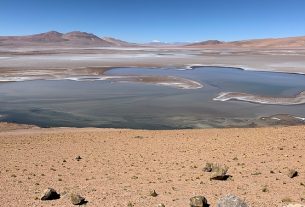According to new findings, a significant fraction of the mass loss of the Antarctic Ice Sheet is due to the thinning of the ice shelves surrounding the continent. An effect mainly related to the warming of the ocean. This is the first time that a study quantifies the importance of this phenomenon. The results were published in the journal Geophysical Research Letters on November 20th.
Observations show that the Antarctic ice cap is losing mass at an accelerated rate due to global warming. However, it is still difficult to say how much this loss will worsen in the decades and centuries to come. Several processes are at stake and their respective roles are still poorly understood. Also, future projections are associated with a considerable margin of uncertainty. Moreover, the risk of collapse of some parts of the cap is not excluded by 2100.
The stabilizing role of ice platforms
A fundamental effect is the evolution of ice platforms (or barriers) around the continent. These consist of terrestrial ice which has flowed to the sea and eventually floated. It is therefore a kind of marine extension of the ice sheet. As a result of flying buttress, these formations tend to slow down the glacial flow upstream. Thus, they play a stabilizing role for the ice cap by limiting the discharge of continental ice to the sea.
However, with the warming of the air and especially water, these barriers are weakened. Some have already disappeared and most are thinning. In fact, scientists have suggested that the rate of export of ice to the ocean should accelerate. And so, contribute to the loss of mass observed. However, so far there has been little data to support this claim. A necessity when one knows the complexity of the glacial dynamics and its coupling with the ocean and the bedrock.
Thinning platforms and increasing exports
It’s done now. For the first time, researchers have unambiguously demonstrated an important cause-and-effect relationship. The period covered by the study is from 1994 to 2017. The data obtained by cross-checking recent observations with very high resolution modeling indicate that the phenomenon is particularly marked in the western Antarctic.
“There are also other processes involved, but we can now firmly say that the changes observed in the ice shelves are causing significant changes in the Earth’s ice, accelerating its flow to the ocean,” says Hilmar Gudmundsson, author paper. “This study fills a significant deficit in our understanding. Lack of data and limitations of modeling made it difficult to quantify the importance of these changes as a driver of mass loss.
While the study is continent-wide, it is not surprising that the mechanism is particularly active at the Thwaites Glacier and Pine Island. Two individuals known to be particularly vulnerable. In addition, the results revealed that when a barrier becomes weakened, the influence spreads almost instantaneously far upstream.
“Generally, we distinguish an instant response and a transient (delayed) response. Our study shows that the thinning of the ice platforms translates into a significant instantaneous response and therefore to an effective mass loss, “explains the lead author. In other words, do not count on a long response time that could delay impacts on sea level rise.




